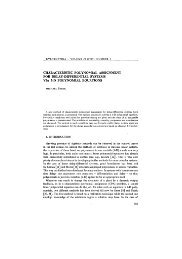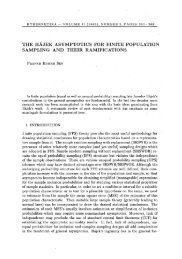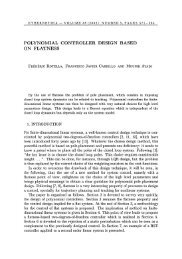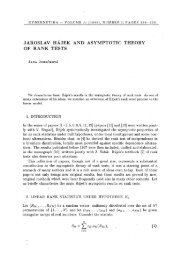tuning the zhu-takaoka string matching algorithm and ... - Kybernetika
tuning the zhu-takaoka string matching algorithm and ... - Kybernetika
tuning the zhu-takaoka string matching algorithm and ... - Kybernetika
Create successful ePaper yourself
Turn your PDF publications into a flip-book with our unique Google optimized e-Paper software.
Tuning <strong>the</strong> Zhu-Takaoka String Matching Algorithm <strong>and</strong> Experimental Results 75<br />
calculate <strong>the</strong> difference as a percentage between our BR <strong>algorithm</strong> <strong>and</strong> <strong>the</strong> existing<br />
<strong>algorithm</strong>s we used <strong>the</strong> following formula. The average number of comparisons<br />
was taken from <strong>the</strong> relevant cell in Tables A1-A4 <strong>and</strong> divided by <strong>the</strong> value for<br />
that pattern length for our BR <strong>algorithm</strong>. This value was <strong>the</strong>n deducted by 1 <strong>and</strong><br />
multiplied by 100 to give <strong>the</strong> percentage difference between <strong>the</strong> two <strong>algorithm</strong>s.<br />
An interesting observation of <strong>the</strong> existing <strong>algorithm</strong>s when compared with <strong>the</strong> BR<br />
<strong>algorithm</strong>, is that for each individual text <strong>the</strong> percentages were within 1 % for each<br />
specific <strong>algorithm</strong>. Each value in Table 2 is calculated by taking <strong>the</strong> difference as a<br />
percentage between each <strong>algorithm</strong> <strong>and</strong> our BR <strong>algorithm</strong> for each pattern length,<br />
adding <strong>the</strong>m toge<strong>the</strong>r <strong>and</strong> dividing by 4. For example, for a pattern length of 4 <strong>the</strong><br />
BM <strong>algorithm</strong> takes on average 51.11% more comparisons than our BR <strong>algorithm</strong>.<br />
Note that <strong>the</strong> figures only include direct comparisons between <strong>the</strong> text <strong>and</strong> <strong>the</strong><br />
pattern <strong>and</strong> not any text comparisons made during <strong>the</strong> calculation of a shift.<br />
Table 2. The average (of Tables A1-A4) percentage difference<br />
in <strong>the</strong> number of comparisons between existing <strong>algorithm</strong>s <strong>and</strong> <strong>the</strong> BR <strong>algorithm</strong>.<br />
pat.len. num. KMP BM HOR RAI TBM MS LDI QS ZT SMI<br />
2 133 199.98 93.96 94.00 93.96 93.89 35.94 37.23 32.92 93.96 31.48<br />
3 765 366.02 64.18 64.20 64.19 63.70 28.78 32.90 28.21 60.03 24.93<br />
4 2178 449.02 51.11 50.86 50.90 50.77 28.25 31.09 25.77 43.19 19.73<br />
5 3146 540.11 45.02 44.58 44.46 44.72 28.33 31.57 26.47 33.91 18.13<br />
6 3852 626.30 42.42 41.83 41.68 41.91 30.02 32.38 27.32 27.71 16.42<br />
7 4042 719.01 41.38 40.92 41.00 40.72 31.49 33.58 28.83 24.94 16.08<br />
8 3607 807.61 40.58 40.28 40.35 39.95 32.27 34.99 30.10 21.67 15.49<br />
9 3088 896.18 41.52 40.92 40.84 40.69 34.75 37.13 32.19 19.29 15.45<br />
10 1971 982.63 42.19 41.69 41.79 41.16 36.62 39.31 34.37 17.75 15.64<br />
11 1120 1067.87 44.14 43.67 43.79 42.97 38.57 42.14 37.18 17.06 16.32<br />
12 593 1164.14 45.28 44.58 44.68 44.20 40.06 44.38 39.28 16.14 17.34<br />
13 279 1245.53 47.88 47.22 47.32 46.36 42.26 46.69 41.61 12.65 17.54<br />
14 116 1322.70 46.74 46.46 46.60 45.16 42.62 48.68 42.26 11.32 17.03<br />
15 44 1426.02 51.20 51.51 51.59 49.23 44.73 52.89 45.29 8.72 19.00<br />
16 17 1527.28 49.34 50.44 50.60 47.37 46.60 52.95 49.06 24.80 20.02<br />
17 7 1598.50 45.29 44.51 44.58 43.42 40.22 50.20 45.01 6.72 16.95<br />
18 4 1700.81 50.58 53.96 54.06 48.54 50.12 59.06 53.59 6.09 22.21<br />
19 0 0.00 0.00 0.00 0.00 0.00 0.00 0.00 0.00 0.00 0.00<br />
20 1 1948.74 58.37 58.12 58.07 58.37 52.25 72.62 63.51 3.01 29.43<br />
21 2 1947.96 57.38 63.98 63.99 56.32 57.59 64.09 57.50 2.22 21.84<br />
22 1 2129.14 50.97 49.87 49.89 50.97 45.07 66.54 55.43 1.04 25.09<br />
Total 24992 737.56 43.29 42.83 42.82 42.65 32.00 34.59 29.72 26.09 16.66<br />
The result of a full search for <strong>the</strong> dictionary over all four texts is given in <strong>the</strong><br />
last row of Table 2. From this we can see that <strong>the</strong> BM <strong>algorithm</strong> is took on average<br />
43.54% more comparisons than our BR <strong>algorithm</strong> (see 5th column, last row) for a<br />
complete search for all <strong>the</strong> words in <strong>the</strong> dictionary.<br />
We also measure <strong>the</strong> user time for <strong>the</strong>se <strong>algorithm</strong>s as <strong>the</strong> saving in <strong>the</strong> number<br />
of comparisons may be paid for by some extra overhead operations. We timed <strong>the</strong><br />
search of bookl of for all occurrences of 500 words from <strong>the</strong> UNIX dictionary. The<br />
words are of length 2 to 11 <strong>and</strong> <strong>the</strong>re are 50 words of each length. The words were<br />
chosen at r<strong>and</strong>om from <strong>the</strong> UNIX dictionary. We show <strong>the</strong> average length of a<br />
shift performed by each <strong>algorithm</strong> in <strong>the</strong> second column. The percentage difference






